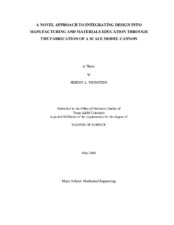| dc.description.abstract | There has been a continuous push among industry, educators, and accreditation organizations to infiltrate all levels of engineering education with design skills development instruments. At Texas A&M University there was the unique opportunity to modify a manufacturing and materials laboratory with this ideal in mind. Prior to 2001 the materials and manufacturing laboratories were independent initiatives. Recently, these courses have been combined into one entity. It was proposed that if these two courses integrated fully under the umbrella of one project, that the students would better understand the nature of product development in design and that this simple change would result in a higher level of learning.
The proposed manufacturing and materials selection project was a 1/8th scale replica of a 12 lb. Civil War Napoleon Cannon in a field mount. The product was selected due to its ease of manufacture and potential for addressing a sufficient variety of materials during development. The development of the product followed a simple timeline. Initially, students took an existing model and used it to develop working drawings. Next the barrel material was selected by examining the performance of two materials using common testing methods. Selected materials were then subjected to heat treatment. Once the material processing was complete; Manual Machining, CNC Machining, Welding and a novel Rapid Manufacturing approach were used to produce the cannons. The cannons were then tested and destroyed for metallographic examination.
A quasi-experimental two by two factorial design was used to evaluate the effects of the innovative laboratory treatment compared with the effects of standard laboratory treatment. Assessment was performed using two instruments. These instruments consisted of three student surveys and two open-ended qualitative essays graded for depth of learning using analytic rubrics. Preliminary results indicate that the students are highly enthused by the new class. Analysis of the open-ended qualitative essays indicate that the students in the treatment, or project-based, laboratory performed at an equal level to those in the non-treatment, or control group. | en |


